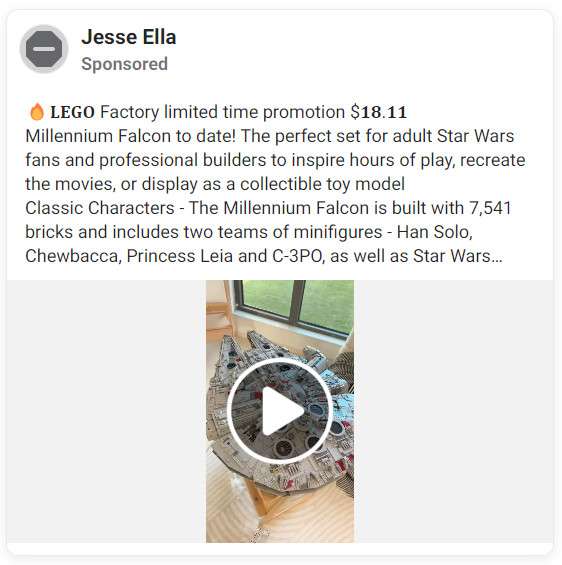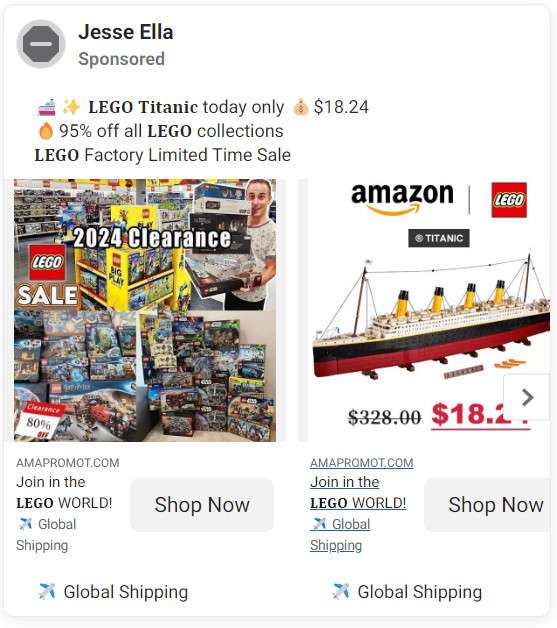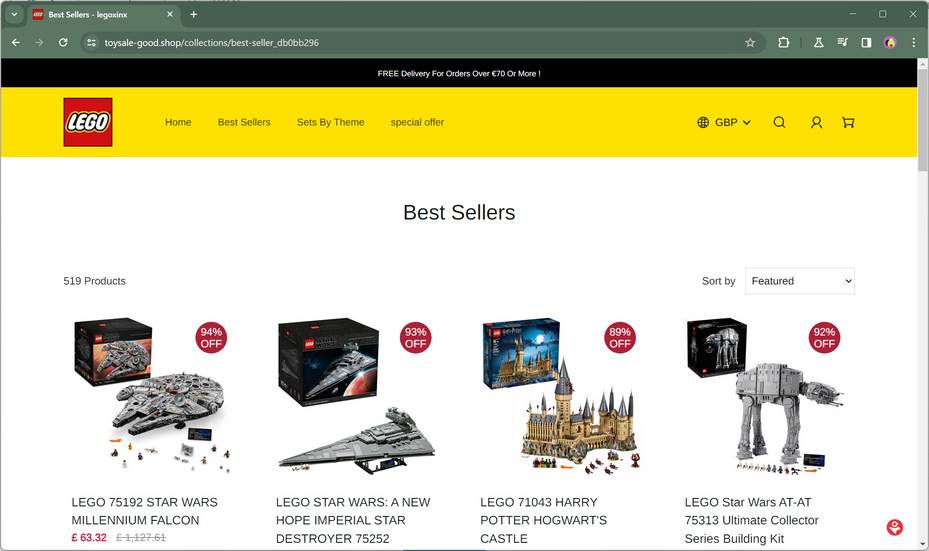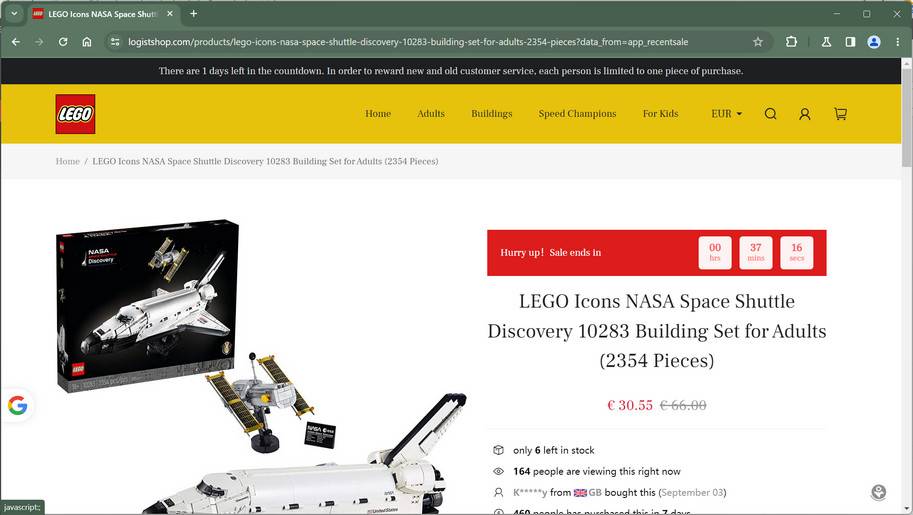Imagine spotting an online ad for the coveted LEGO Millennium Falcon set priced at only $18.11. As a loyal LEGO fan, you’d probably leap at the chance to add this holy grail kit to your collection at 95% off retail. But before smashing that Buy button, beware – unbelievably cheap LEGO deals can often turn out too good to be scam.
Fraudsters are running elaborate fake LEGO factory sales on social media and scam websites, duping customers into paying for sets that never get shipped. Let’s dive into how this deception works and make sure your next LEGO spree doesn’t leave you brick broke.



Scam Overview
The LEGO Factory Limited Time Sale scam typically begins with fraudulent social media advertisements promising unbelievable discounts on LEGO sets – up to 95% off retail prices. The ads are carefully designed to target LEGO fans of all ages who would be highly motivated by the prospect of scoring extremely discounted LEGO sets.

The ads feature tantalizing headlines such as:
“🚢✨ LEGO Titanic today only 💰$18.24”
“🔥95% off all LEGO collections”
“LEGO Factory Limited Time Sale”
Other common bait includes:
“🔥LEGO Factory limited time promotion $18.11”
“LEGO Warehouse Clearance Sale – Up to 90% Off!”
“Last Chance for LEGO Sets – All Stock Must Go!”
The ads also leverage scarcity and urgency tactics, such as “today only” or “limited time offer”, to convince potential victims they must act fast before the fictional promotion ends. Countdown timers are sometimes used as well to increase the pressure.
The scam ads appear carefully designed to mimic real LEGO marketing campaigns. They feature the LEGO logo prominently, as well as actual images of popular LEGO sets like the Millennium Falcon, LEGO City sets, Harry Potter, and more. For the unaware, the ads give the false impression that LEGO is directly behind the promotions.
In reality, these ads have absolutely no connection to the LEGO Group whatsoever. Scammers simply use the LEGO brand illegally to perpetrate their fraud. When victims click on the social media ads, they are redirected to elaborate scam websites that continue the ruse.
These fraudulent sites utilize LEGO’s trademarks, official product imagery, and even Lego.com’s website design elements to appear legitimate. However, they are operate solely to deceive customers and collect payments.
The fake webstores feature almost every popular LEGO set available, all listed at absurdly low prices like $18 for a $500 Millennium Falcon set. The goal is to dupe shoppers into believing they are purchasing authentic LEGO sets for over 90% off retail value.

To increase credibility, the scam sites sometimes list phone numbers, physical addresses, and customer service email addresses. However, these contact details are fake and tracing them leads to dead ends. The numbers don’t work, the addresses don’t exist or are unrelated to the scammers, and emails go unanswered.
After luring victims in with social media bait and elaborate fake websites, the scammers collect payment information through integrated payment processors like PayPal, Stripe, and Square. This builds additional trust, since customers assume no legitimate payment company would work with a fraudulent seller.
In reality, the scammers simply setup payment processing just like any business could. The scam works because once payments are collected, no LEGO sets are ever shipped. The criminals disappear with the payments and are virtually untraceable.
Customers who fell for the bait never receive the deeply discounted LEGO sets they ordered. If any shipment eventually arrives, it will likely contain a cheap LEGO knockoff made from inferior materials, or something totally random like a $2 bracelet. This tactic prevents payment processors from realizing right away that a scam took place.
The LEGO scam takes advantage of loyal LEGO fans who would be strongly motivated by the prospect of acquiring expensive, hard-to-find sets for up to 95% off normal prices. The ads and websites initially seem authentic and convincing to the unaware.
By the time victims realize they’ve been defrauded, the fake websites have vanished and the criminals are long gone. Customer payments are gone as well, with virtually no way to receive refunds or recover lost money.
This devastating scam has played out across social media and legitimate shopping websites repeatedly. Aspiring LEGO collectors of all ages have been duped while attempting to expand their collections on the cheap. Even experienced LEGO buyers can be deceived if they don’t look closely for warning signs.
The LEGO Group advises customers only to purchase LEGO products through authorized retailers. If a deal seems too good to be true, it undoubtedly is. LEGO sets rarely go on extremely deep discount legitimately.
With the LEGO brand being so trusted and beloved, scammers will continue creating increasingly elaborate fakes to cash in on that popularity. Stay vigilant and think twice before handing over payment information, no matter how amazing the supposed LEGO deal may look.
Scammers Heavily Advertise Rare Sets Like Millennium Falcon and Titanic
A common tactic scammers use to entice LEGO collectors is advertising extremely rare, high-value sets like the Millennium Falcon and Titanic for absurdly low prices.
For example, many fake LEGO Factory Sale ads will promote the $500 Millennium Falcon set for just $18.11 or $29. Or the retired Titanic set, which sells for over $1,000 used, gets listed for crazy low prices like $9.99 or $19.90.
These desirable sets with huge retail markups are used as bait since dedicated LEGO fans would jump at the chance to buy them so cheaply. Seeing the Millennium Falcon set at 95% off would certainly catch any collector’s attention!
Of course the reality is these scam websites never possess such rare sets to begin with. But that doesn’t stop them from leveraging the demand to attract victims. Once purchases are made, customers simply never receive the advertised kits.
So while it may be tempting to finally grab an amazing white whale LEGO set at an unbelievable discount online, extraordinary skepticism is required. There’s virtually no legitimate reason for a retired $1,000 set to sell for $20 or less overnight.
When encountering once-in-a-lifetime LEGO deals like this, the wise move is trusting your instincts that it’s clearly too good to be true. Remember, if it seems fake, it almost certainly is. Protect your wallet and avoid the scam artists attempting to profit off your love of LEGO!
How the Scam Works
While individual fake Lego factory sale scams may differ slightly in their tactics, most follow the same general steps to defraud customers:
Step 1 – Baiting Customers with Social Media Ads
The scam begins with fake ads posted on social platforms like Facebook, Instagram, and TikTok. The ads are made to look official and will use Lego branding without permission. Images of popular Lego sets are used that match the impossibly low prices advertised.
The ads are targeted towards Lego fans of all ages who would naturally be very excited by a 90% discount on expensive Lego sets that are normally out of their budget. The use of “act now”, “today only” and other high-pressure sales tactics create urgency.
Step 2 – Directing Victims to Fraudulent Websites
When potential victims click on the social media ads, they are redirected to sophisticated scam websites designed specifically to mislead customers and collect payment information.
The sites have domain names unrelated to Lego, but this usually goes unnoticed. The webpages are cluttered with Lego branding and images illegally scraped from the official Lego website and other locations around the web.
To seem more legitimate, the sites list physical addresses with Google Maps integration. However, the addresses are either fake or point to unrelated properties that have no affiliation with the scammers. Any phone numbers, emails or contact forms don’t actually work.
Step 3 – DuPonting Shoppers with Fictional Discounts
The online stores feature almost every popular Lego set, all listed at absurdly low prices – a $500 set might be shown at $18.11. These jaw-dropping discounts up to 95% off are completely fictional and intended to trick customers.
Scarcity and urgency tactics are used, including countdown timers and warnings that limited quantities are left. In reality, there is no actual Lego inventory for sale and no time limitations.
Images of the Lego sets are stolen from other websites. At quick glance, the sites look so convincing that victims don’t realize the deception.
Step 4 – Collecting Payments and Credit Card Details
The scam sites integrate with legitimate online payment processors like PayPal, Stripe and Square to collect payments from victims. This helps build trust since customers assume no credit card processor would work with a fraud website.
In reality, the scammers have simply signed up for payment processing services just like any legitimate online merchant could. Eventually the scam is uncovered and their payment accounts are shut down, but by then they have already defrauded many shoppers.
Payment options may also include bank wires, gift cards, Western Union or MoneyGram. These methods offer no buyer protection and make it impossible for victims to recover lost funds. Cryptocurrency payments are also sometimes accepted.
Of course, no Lego sets are ever shipped and the scammers disappear with the payments. Any personal information entered on the sites – like names, addresses and phone numbers – is also now in the hands of criminals.
Step 5 – Running Away with the Money
After collecting enough payments, the scammers abandon their fake sites and are never heard from again.
The domains used for the scam websites are usually registered anonymously just for the short period of operation. After shutting the sites down, the criminals disappear without a trace along with any payments made by customers.
Angry customers who were duped find that the websites and any contact information provided were completely fake. There is no way for them to recover their money or personal data.
The fraudsters will often reappear weeks or months later with new domains and social media ads to run the same scam on new batches of customers who haven’t previously encountered the trap.
How to Spot the Fake LEGO Factory Sale Scam Websites
While the fraudulent LEGO factory sale websites are designed to look convincing, there are several red flags consumers should watch out for:
- Website URL/domain – The sites use domain names unrelated to LEGO or use slight misspellings like leggosale.com. Recently registered domains are a sign of a scam.
- Contact information – There will be no legitimate contact info beyond a web form or dubious email address. Listed physical addresses either don’t exist or are unrelated. Phone numbers go unanswered or disconnected.
- Pricing – Deep discounts of 50-90% off are a telltale indicator of fraud. A $500 LEGO set selling for $18 is too good to be true.
- High pressure tactics – Scam sites use urgency (“act fast”, “today only”) or scarcity (“only 2 left!”) to rush customers. Countdown timers pressure shoppers to buy before the fake sale ends.
- Payment methods – Scams tend to favor credit cards, gift cards, bank wires, Western Union, or cryptocurrency. Avoid sites not offering secure mainstream payment options.
- Language errors – Bad grammar, typos and other writing issues signal an amateur scam operation. Authentic brands meticulously avoid these mistakes.
- Policy details – Fake sites lack in-depth policies for shipping, returns, warranties and other key details real brands display prominently.
- Images – A Google image search reveals the product photos are stolen from authentic LEGO sites or Amazon listings.
- Branding issues – Improper use of the LEGO logo or demonstrably fake claims of affiliation with LEGO are other scam giveaways.
- Slogans – Tricky slogans like “Going out of business”, “Warehouse clearance”, or “Limited edition” are utilized to create false urgency despite no real relation to LEGO.
Consumers should trust their instincts when a deal seems unrealistic. Verify seller legitimacy and look for consensus from other shoppers who bought from the website before making purchases. Only obtaining LEGO sets from authorized retailers will help avoid scams.
How to Identify Fake LEGO Sales on Social Media
Scammers rely heavily on major social platforms like Facebook, Instagram and TikTok to promote their fake LEGO factory sales. Here are tips for each platform:
- Headlines contain enticing slogans like “Warehouse Clearance”, “Going out of Business”, or “Today Only” sales with unrealistic discounts up to 90% off.
- Video ads mimic LEGO marketing but link to scam websites. Comments are disabled to hide negative feedback.
- Image posts feature stolen official LEGO photos along with misleading captions about huge savings events.
- Check advertiser profile for legitimacy – scammers use fake profiles with stock images. Recent account creation dates are a red flag.
- Scam ads tend to target LEGO interest groups and fan pages specifically.
- Fake LEGO discount posts use eye-catching captions like “Final clearance! All sets 90% off!”
- Stories or Reels with urgent calls to action: “Sale ends in 1 hour!” create false pressure to purchase quickly.
- Little or no follower engagement on scam accounts, or followers appear as fake bot accounts.
- Ad profiles use LEGO hashtags but lack any other legitimate branding or company information.
- Comments raising concerns about fraud are deleted immediately by scammers.
TikTok
- Videos announcing unbelievable “going out of business” or “warehouse liquidation” sales with prices like $18 for a $500 set.
- AI-generated voiceovers, images and footage meant to look official are used alongside claims of blowout discounts.
- Urgency tactics communicate limited quantities and flash sale time windows to spur impulse buying.
- Scam accounts have limited followers and zero engagement on their scam videos.
- Links in bios and captions route to fraudulent store sites to capture payment information.
By leveraging social proof on major platforms, scammers aim to boost perceived legitimacy and trick loyal LEGO fans. But learning their techniques makes it easier to avoid being swindled.
What to Do if You Are a Victim of the Scam
If you have placed an order or given your payment information to one of these Lego fake factory sale scams, there are steps you should take right away:
- Contact your credit card company or payment provider: Report the charges as fraudulent right away. Doing this quickly can greatly increase your odds of recovering lost funds. Provide details about the scam website and seller.
- Report the incident to the FTC: File a complaint with the Federal Trade Commission about the fraud at ReportFraud.ftc.gov. The FTC uses consumer complaints to help track down scammers and stop their operations.
- Report the scammers to social media platforms: Contact Facebook, Instagram, TikTok etc to report the fake ads and accounts used to promote the scam. Getting fraudulent ads removed quickly can prevent further victims.
- Warn others: Leave comments about the scam on the social media posts, scam sites (if still active) and scam reporting websites to make the fraud more visible in search results. This can help warn other potential victims when they research.
- Review account statements: Closely monitor your financial accounts used to make payments for any signs of identity theft or misuse of information. Scammers may sell or use collected data for other frauds.
- Change passwords: Update passwords on any websites where you used the same login credentials you entered on the scam site. Assume credentials provided to scammers may now be compromised.
- Watch for communications: Be cautious of any calls, emails or texts received related to the incident. Scammers sometimes use these methods to continue targeting victims.
Frequently Asked Questions About the Fake LEGO Factory Sale Scam
1. How do I spot a fake LEGO sale on social media?
Look for ads with exaggerated claims like “50-90% off”, “going out of business”, or “flash sale”. Scammers also create a false sense of urgency with “act now before sale ends” messages. Research advertiser profiles for legitimacy – scam accounts often have stock images and were recently created. Be skeptical of unbelievable prices like $18 for a $500 set.
2. What are signs of a scam LEGO website?
Red flags include steep discounts over 50%, high-pressure tactics, suspicious contact info, recently registered domain names, grammatical errors, fake addresses, and scraped LEGO imagery. No physical LEGO retailer would offer brand new sets at 90% off retail value.
3. Can I get scammed using PayPal on a fake site?
Yes, you can still be scammed. The sites appear legitimate by integrating PayPal and major processors. But they never ship products, so PayPal buyer protection won’t apply. Your best bet is not engaging with sketchy sites to begin with.
4. I entered my credit card on a scam site – now what?
Immediately contact your credit card company and report the charges as fraudulent. Request a chargeback to potentially recover lost funds. Monitor your statements closely for any suspicious charges going forward as your data may be compromised.
5. How can I tell if a LEGO set is fake or counterfeit?
Fake LEGO sets purchased from scam sales will appear noticeably lower quality upon arrival – flimsier materials, missing LEGO branding inside pieces, misshapen or poor fitting bricks. The packaging may also appear cheaply made or damaged. Authentic LEGO sets have meticulous quality control.
6. Is there any way to get back the money I lost to a LEGO scam?
Unfortunately, recouping financial losses is very rare once scammers disappear with your money. Your only options are reporting unauthorized credit charges right away and filing a complaint with the FTC. Be highly vigilant about offers that seem too good to be true.
7. Where should I buy LEGO sets from safely?
Only buy directly from LEGO via Lego.com or official LEGO stores. Reputable major retailers like Amazon, Target and Walmart also offer authentic sets. Special deals above 25% off should be verified. For rare sets, stick to vetted sellers with solid feedback scores.
8. How can I help stop these LEGO scams?
Reporting scam social media posts and websites to the respective platforms can help get them taken down faster. Sharing warnings online helps educate other fans. Avoid engaging with suspicious promotions to begin with – that helps scammers profit off the deception.
9. Why do scammers focus so much on LEGO products?
LEGO’s brand appeal, high prices for major sets, and collector appeal make it a prime target. Scammers know LEGO superfans will be intrinsically motivated to buy into phony factory sales or clearance events for beloved kits. Strong demand enables high volumes of scam attempts.
10. Are the LEGO scammers ever caught or punished?
Unfortunately, most evade law enforcement due to using fake identities and untraceable payment methods online. Persistent cases may be investigated by consumer protection groups, but offenders rarely face legal consequences. Continued vigilance by consumers is key to disrupting the scam operations.
The Bottom Line
The fake Lego factory sales scam shows how important it is to be wary of unbelievable deals and high-pressure sales tactics online. If an offer seems too good to be true, it very likely is.
When shopping online, be sure to research sellers thoroughly before making any purchases or providing personal information. Deals that seem unrealistic, combined with shady seller behavior like completely lacking contact information, are almost guaranteed warning signs of a scam.
Lego fans looking for discounted sets should only shop directly through official brand channels – Lego.com, Certified Lego Stores, and authorized major retailers that are known to sell authentic products. There are no secret warehouse overstock sales or going out of business blowouts.
Stay vigilant and avoid letting the excitement of scoring an ultra-discounted Lego set override your common sense online. Following safe shopping practices will help protect you from sneaky scammers aiming to profit off your love of Lego bricks.










